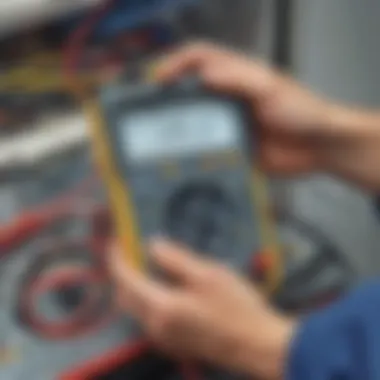Mastering Voltage Measurement: A Comprehensive Guide to Using a Multimeter


Science Fun Facts
In the world of electrical engineering, did you know that voltage is often described as the 'pressure' of electricity flowing through a circuit? This pressure pushes the electrical current to move from one point to another, playing a crucial role in how electricity operates. Understanding voltage is fundamental to grasping the basics of electrical systems and troubleshooting effectively.
Discover the Wonders of Science
Science Experiment Showcase
Fun Science Facts
Did you know that voltage is measured in volts, named after the Italian physicist Alessandro Volta? Volta was a pioneer in the study of electricity, known for inventing the first chemical battery. His contributions to the field laid the groundwork for modern-day electrical concepts, making him a significant figure in the history of science and technology.
Understanding Voltage Measurement
To grasp the concept of voltage measurement using a multimeter, it's crucial to comprehend the relationship between voltage, current, and resistance in an electrical circuit. Voltage represents the electrical potential difference between two points in the circuit and is measured in volts. By connecting the multimeter in parallel to the components being tested, you can accurately determine the voltage across them, aiding in troubleshooting and maintenance tasks.
Safety Precautions and Best Practices
When engaging in voltage measurement activities, prioritizing safety is paramount. Always double-check the multimeter settings to ensure it is set to the correct voltage range before making any measurements. Avoid touching exposed conductors while the circuit is live, and use insulated probes to prevent electric shocks. Remember to remove jewelry and metal accessories that could conduct electricity to guarantee a safe testing environment.
Applying Voltage Measurement Skills
Once you have honed your voltage measurement skills using a multimeter, you can apply this knowledge to various real-world scenarios. From diagnosing faulty electrical outlets to troubleshooting automotive circuits, the ability to measure voltage accurately empowers you to tackle a multitude of electrical problems effectively. Practice measuring voltage in different circuits to gain confidence and proficiency in utilizing this indispensable skill.
Introduction to Voltage Measurement
Voltage measurement is a critical aspect in the field of electrical systems. Understanding how to accurately measure voltage using a multimeter is indispensable for troubleshooting and maintenance tasks. This section serves as a foundational guide for individuals seeking to delve into the intricate world of electrical measurements. By highlighting the key points of voltage measurement and its relevance, readers will gain a comprehensive understanding of this essential skill set. Overviews of different types of multimeters and their functions will be explored to provide a holistic view of voltage measurement techniques.


Understanding the Importance of Voltage Measurement
The significance of voltage in electrical systems
Voltage plays a fundamental role in electrical systems by determining the force that drives electric current. It signifies the potential energy difference between two points in a circuit, essential for the functioning of various electrical components. The accurate measurement of voltage ensures the safety and efficiency of electrical devices, making it a crucial aspect of electrical maintenance. Voltage also helps in diagnosing circuit issues, enabling swift troubleshooting and repairs.
Real-world applications of voltage measurement
The real-world applications of voltage measurement are diverse and crucial across various industries. From testing batteries to checking power supplies in electronic devices, measuring voltage is a common practice. In household settings, voltage measurement aids in ensuring the proper functioning of appliances and electrical outlets. Through precise voltage readings, professionals can identify faulty components, prevent electrical hazards, and optimize the performance of electrical systems.
Overview of Multimeters
Types of multimeters available
Multimeters come in various types, including digital and analog versions, with each offering unique features and functionalities. Digital multimeters provide accurate measurements with digital displays, ideal for precise voltage readings. On the other hand, analog multimeters offer continuous voltage range variations, suitable for detecting fluctuating voltage levels. Understanding the types of multimeters available is essential for selecting the right tool for specific voltage measurement tasks.
Functions and features of a typical multimeter
A typical multimeter comes equipped with functions such as voltage measurement, resistance testing, and continuity checks. These features allow users to perform comprehensive electrical inspections, identify faulty components, and troubleshoot circuit problems effectively. With the ability to measure AC and DC voltage, as well as other parameters like current and resistance, multimeters offer versatile solutions for a wide range of electrical applications. By exploring the functions and features of multimeters, readers will grasp the importance of this versatile tool in voltage measurement.
Preparing to Measure Voltage
In the realm of electrical systems, the process of voltage measurement holds a paramount significance that cannot be understated. Before delving into the actual measurement of voltage using a multimeter, it is crucial to prepare adequately to ensure accurate readings and personal safety. The section on 'Preparing to Measure Voltage' serves as the foundation for the entire exploration of voltage measurement using a multimeter.
Selecting the Correct Multimeter Setting
Understanding the voltage range to be measured


A key aspect of voltage measurement using a multimeter is understanding the voltage range that needs to be measured. By comprehending the voltage levels present in the circuit or system being tested, one can select the appropriate range on the multimeter for precise measurements. This understanding not only ensures accurate readings but also prevents damage to the multimeter due to voltage overload. The ability to correctly identify and set the voltage range reflects the acumen of the individual in handling electrical measurements effectively.
Setting the multimeter to the appropriate voltage range
Once the voltage range is determined, the next step involves setting the multimeter to the corresponding range. This action is crucial in obtaining precise voltage readings without compromising the accuracy of the measurement. The multimeter setting should match the expected voltage range to prevent errors or inaccuracies in the readings. By setting the multimeter correctly, one can streamline the measurement process and derive reliable data for diagnostic or troubleshooting purposes. The proper adjustment of the multimeter further exemplifies the user's competence in utilizing this essential tool for voltage measurement.
Ensuring Safety Measures
Importance of personal protective equipment (PPE)
Amidst the technicalities of voltage measurement, the aspect of personal safety must not be overlooked. The inclusion of personal protective equipment (PPE) stands as a fundamental measure in safeguarding individuals against electrical hazards during the measurement process. Equipping oneself with insulating gloves, safety glasses, and appropriate attire reinforces the importance of personal safety in the realm of voltage measurement. The utilization of PPE signifies a proactive approach towards minimizing risks and ensuring a secure working environment.
Safe handling practices while using a multimeter
Alongside PPE, implementing safe handling practices while using a multimeter is imperative for overall safety and accuracy. Proper handling techniques, such as ensuring insulated test leads and avoiding contact with live components, are essential in mitigating potential risks associated with electrical measurements. Attention to detail in handling the multimeter not only enhances personal safety but also contributes to the longevity of the equipment. Embracing safe handling practices reflects a conscientious attitude towards conducting voltage measurements effectively.
Conducting Voltage Measurement
When delving into the realm of electrical systems, the topic of conducting voltage measurement stands out as a crucial aspect in troubleshooting and maintenance processes. Proper voltage measurement provides essential insights into the functionality and health of circuits, allowing for targeted repairs and optimizations. By accurately measuring voltage levels, technicians can identify potential issues such as voltage drops or overvoltage situations, enabling them to address these problems proactively. Conducting voltage measurement using a multimeter ensures precise readings, facilitating the diagnosis of electrical irregularities and the seamless operation of various devices and systems.
Connecting the Multimeter
Proper Connection of Test Leads to the Circuit
The proper connection of test leads to the circuit is a fundamental step in the voltage measurement process. Ensuring that test leads are correctly attached to the designated points on the circuit guarantees accurate readings and minimizes the risk of errors. This meticulous procedure involves securing the test leads to the correct terminals, following the polarity markings to maintain the integrity of the measurement. An improper connection can lead to erratic readings and potential safety hazards, highlighting the critical importance of this element in the overall voltage measurement task. By focusing on the precise connection of test leads, technicians can enhance the reliability and effectiveness of their diagnostic procedures, setting a solid foundation for troubleshooting activities.
Ensuring Secure Connections for Accurate Readings


Securing connections for accurate readings is paramount to obtaining reliable voltage measurements. By verifying the tightness and stability of the connections between the test leads and circuit components, technicians can mitigate the impact of external factors on the measurement process. Loose or unstable connections can introduce noise and inaccuracies into the readings, jeopardizing the diagnostic accuracy and complicating the identification of underlying issues. Prioritizing secure connections not only guarantees the integrity of the voltage measurements but also streamlines the troubleshooting process by providing dependable data for analysis. Moreover, by maintaining secure connections throughout the measurement task, technicians can ensure consistent and valid results, fostering an efficient and systematic approach to electrical testing.
Reading and Interpreting Voltage Values
Understanding Display Readings on a Multimeter
A pivotal aspect of voltage measurement involves comprehending the display readings presented on a multimeter. The digital or analog output of a multimeter conveys essential information regarding the voltage levels in the circuit, enabling technicians to assess the electrical characteristics with precision. Understanding how to interpret these display readings is foundational to effective troubleshooting, as it facilitates the identification of anomalies or deviations from expected values. By grasping the nuances of multimeter displays, technicians can gain valuable insights into the circuit behavior, guiding them towards informed decisions and targeted interventions for optimal performance.
Interpreting Voltage Values for Troubleshooting Purposes
Interpreting voltage values for troubleshooting purposes serves as a strategic approach to diagnosing electrical issues and ensuring system functionality. By analyzing the voltage levels across different components and sections of the circuit, technicians can pinpoint irregularities and potential malfunctions. The ability to interpret voltage values allows for the efficient identification of faulty components, facilitating the isolation of problematic elements and streamlining the repair process. Moreover, by correlating voltage readings with expected values and operational parameters, technicians can form a coherent diagnostic strategy, enhancing the accuracy and efficacy of their troubleshooting endeavors.
Troubleshooting Voltage Issues
In this segment of the article, we delve into the critical aspect of troubleshooting voltage issues, a pivotal skill for individuals engaged in electrical systems maintenance and repair. Troubleshooting voltage issues involves identifying and resolving common problems that may occur within circuits, ensuring optimal performance and safety. By addressing voltage issues promptly, technicians can prevent potential equipment damage or circuit failure, enhancing the overall reliability of electrical systems.
Identifying Common Voltage Problems
Voltage drop issues in circuits
Voltage drop issues in circuits are a prevalent concern in electrical systems, characterized by a drop in voltage levels across components or conductors due to resistance. This phenomenon can lead to inadequate power delivery, affecting the performance of connected devices and equipment. Voltage drop issues often occur in long wiring runs or circuits with high current flow, necessitating proper assessment and mitigation strategies. By understanding the causes and implications of voltage drop, technicians can take proactive measures to ensure efficient power distribution within circuits.
Overvoltage situations and their implications
Conversely, overvoltage situations pose another significant challenge in electrical systems, involving voltage levels that exceed the designated thresholds. Overvoltage can result from power surges, faulty equipment, or external interference, posing risks to connected appliances and sensitive electronics. Addressing overvoltage promptly is essential to prevent equipment damage, electric shocks, or fire hazards. By recognizing the signs of overvoltage and implementing protective measures, technicians can safeguard both equipment and personnel from potential harm.
Using Voltage Measurements for Diagnosis
Analyzing voltage fluctuations
The analysis of voltage fluctuations plays a crucial role in diagnosing and resolving electrical issues within circuits. Voltage fluctuations refer to variations in voltage levels over time, impacting the stability and performance of electrical systems. By monitoring and analyzing voltage fluctuations, technicians can pinpoint irregularities, identify potential faults, and implement corrective measures to maintain system integrity and reliability. Analyzing voltage fluctuations enables technicians to detect underlying issues that may not be apparent initially, facilitating comprehensive troubleshooting and resolution.
Isolating faulty components through voltage testing
Voltage testing serves as a reliable method for isolating faulty components within electrical systems, enabling technicians to identify defective parts and replace them accordingly. By performing voltage tests at different points in a circuit, technicians can determine the integrity of components, validate proper functionality, and isolate malfunctioning elements. Voltage testing aids in the localization of faults, streamlining the diagnosis process and expediting repairs. Through systematic voltage testing, technicians can efficiently troubleshoot electrical systems, ensuring optimal performance and safety standards.







